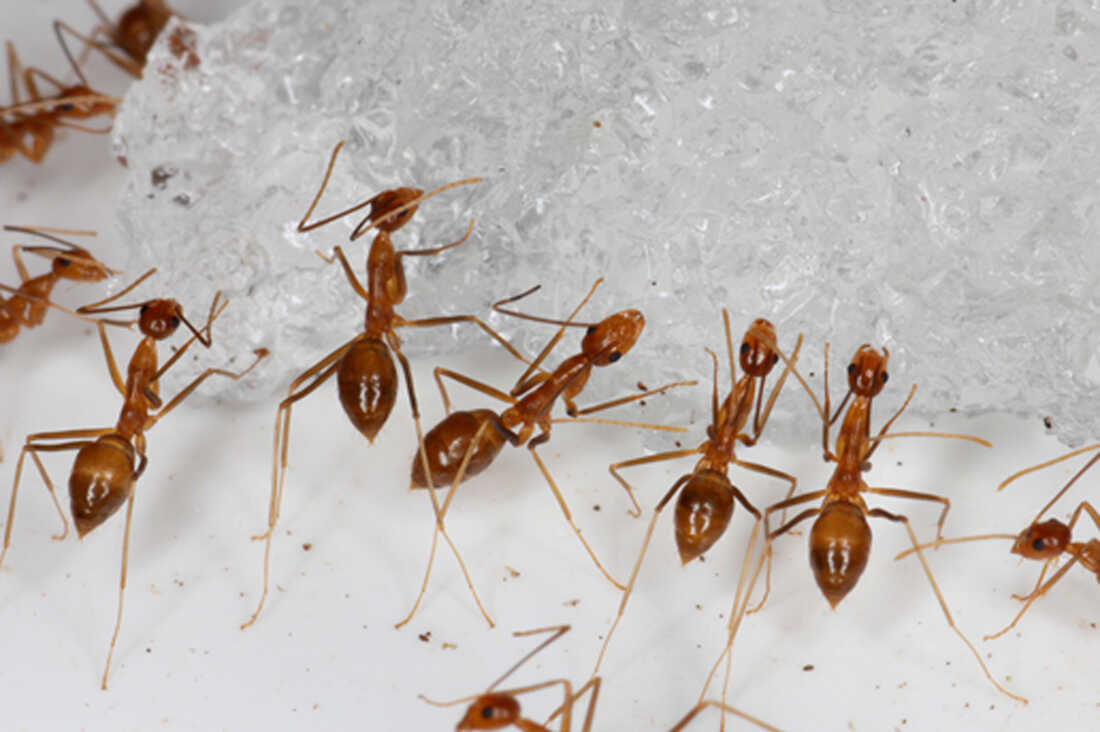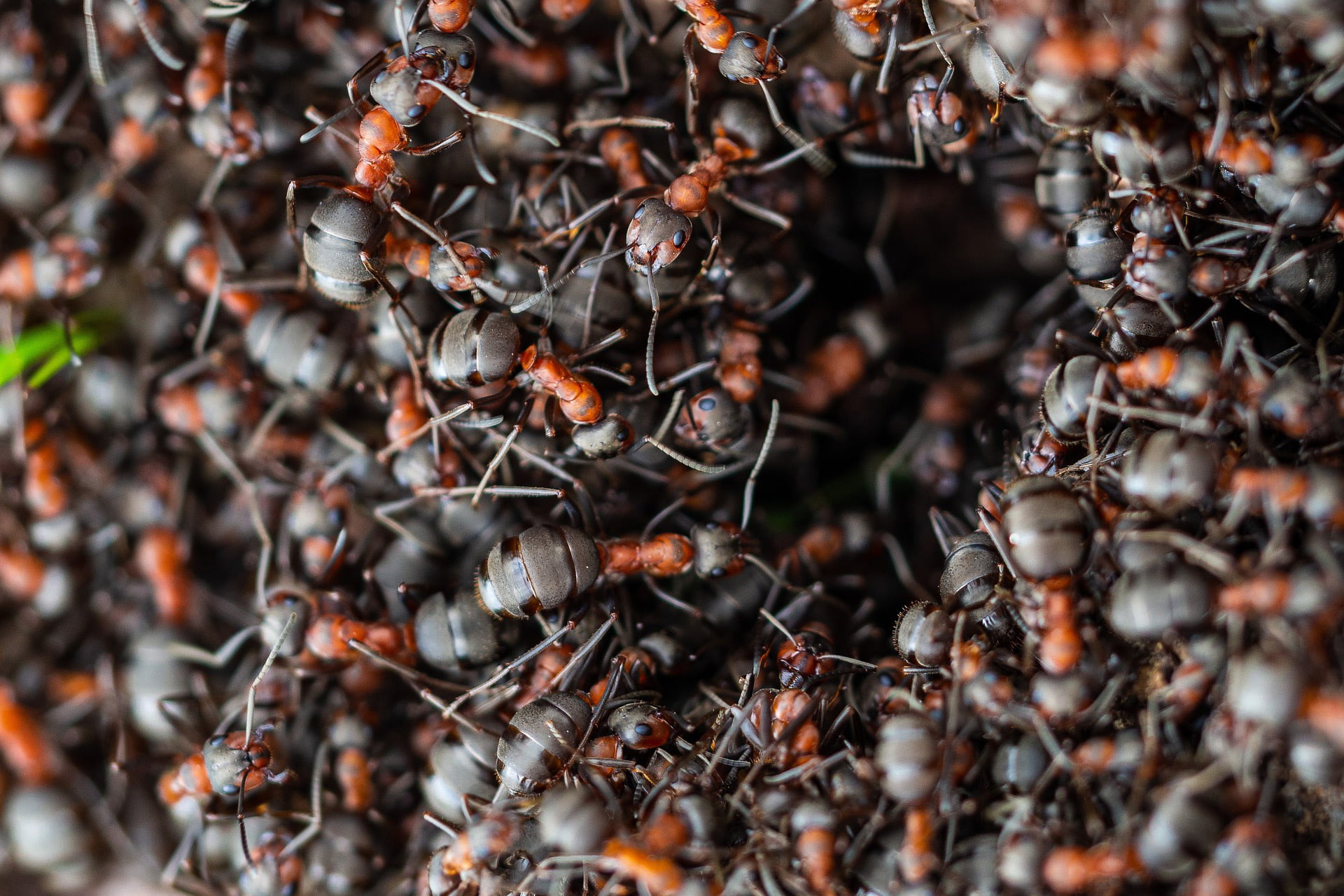There are an estimated 10 to 100 quadrillion ants in the world. Ants are found worldwide and are highly numerous in hot climates, with colonies ranging from a few to over a million ants.
They play vital roles in ecosystems as they belong to the order Hymenoptera, which also includes bees and wasps. Ants are known for their social behavior, with distinct castes such as queens, workers, and soldiers. Their life cycle comprises egg, larva, pupa, and adult stages, and they are crucial for tasks like nest maintenance and food gathering.
With their phenomenal abundance and diversity, ants are an essential part of the global ecosystem.

Credit: 8billiontrees.com
Ants: Small Insects With A Mighty Presence
Ants, the small insects with a mighty presence on Earth, are estimated to outnumber any other insect species. Found worldwide but most abundant in hot climates, these social insects work collectively in colonies ranging from a few to over a million individuals.
Scientists believe there could be around twenty quadrillion ants globally.
Introduction To Ants
Ants are small insects that are found throughout the world. Despite their tiny size, they have a mighty presence in the animal kingdom. They are known for carrying objects much heavier and bigger than themselves, displaying incredible strength and teamwork. Ants are social insects and belong to the order Hymenoptera, which also includes bees and wasps. Entomologists, the scientists who study insects, estimate that there are probably more ants than any other kind of insect. Ants occur in various climates, but they are particularly abundant in hot regions.
Ant Characteristics
Ants usually come in yellow, brown, red, or black colors. They have six legs attached to their thorax, and their mouth is an important working tool. Ants use their mouths for several tasks, including carrying objects and digging. Different species of ants have unique features. For example, harvester ants have short, heavy, crushing jaws for breaking seeds, while the jaws of certain species, like the Amazon ants, are sickle-shaped like a curved tool. Ants have two slender, pointed rods called antennae that constantly wave from their heads while they move. These antennae serve as their senses of smell and touch.
Ant Behavior And Social Structure
Ants do not act individually but rather behave according to the needs of their colony and their assigned jobs. The number of ants living in one nest can range from a few to more than a million. The life cycle of an ant typically has four stages: egg, larva, pupa, and adult. Additionally, ants have three major castes: queens, workers, and soldiers. The workers, who are female ants, are responsible for keeping the colony in order. They care for the young, enlarge the nest, and gather food to feed the queen and other members of the colony. The larger workers, also known as soldiers, defend the nest against threats.

Credit: www.npr.org
The Astonishing World Of Ants
Ants are incredible insects that have a significant presence throughout the world. Their diverse species, unique castes, and impressive abundance and distribution make them an essential component of ecosystems around the globe.
Abundance And Distribution Of Ants
Ants are known to be incredibly abundant, with a global presence that spans across various climates. They have adapted to thrive in a wide range of environments, from scorching deserts to lush rainforests, making them one of the most successful insect species on the planet.
Variety Of Ant Species
There is an astonishing variety of ant species, each with its unique characteristics and behaviors. From the tiny pharaoh ants to the powerful army ants, the sheer diversity of these insects never fails to marvel researchers and enthusiasts alike. The sheer number and variety of ant species reflect their incredible resilience and adaptability.
Life Cycle And Castes Of Ants
Ants undergo a fascinating life cycle, progressing through stages of egg, larva, pupa, and adult. Within a colony, ants fulfill specific roles as queens, workers, and soldiers. Each caste plays a vital part in maintaining the functionality and productivity of the colony, working together seamlessly in their specialized roles.
Quantifying The Ant Population
Ants are fascinating creatures that have flourished in various environments across the globe. Understanding the vastness of their population and their significance in the ecosystem is crucial. Exploring estimations, comparing ant numbers to humans, and examining ant populations across different regions provide valuable insights into the abundance of these tiny yet influential insects.
Estimations Of Ant Populations
Entomologists have estimated that ants outnumber any other type of insect on the planet. Their global population is believed to be in the millions of billions, showcasing the immense presence of these industrious insects. These estimations highlight the widespread distribution and abundance of ants, emphasizing their essential role in various ecosystems.
Comparing Ant Numbers To Humans
It is astonishing to compare the staggering number of ants to the global human population. While there are approximately 7.9 billion humans on Earth, the abundance of ants surpasses this figure by a significant margin. This comparison underscores the immense impact that ants have on the natural world and emphasizes the necessity of studying and understanding their populations and behaviors.
Ant Populations Across Different Regions
Ant populations exhibit remarkable diversity across different regions, with varying species thriving in diverse climates and environments. From tropical rainforests to arid deserts, ants have adapted and proliferated, playing vital roles in their respective ecosystems. Understanding the distribution and density of ant populations in different regions provides valuable insights into their ecological significance and emphasizes the need for conservation efforts to preserve their habitats.
Ants: A Powerful Force In Nature
Ants, a powerful force in nature, are believed to number in the quadrillions worldwide. These social insects, known for their ability to carry objects heavier than themselves, are found in every corner of the globe, with hot climates being particularly abundant in ant populations.
Ecological Impact Of Ants
Ants play a crucial role in the ecosystem due to their ecological impact. They are considered a powerful force in nature, influencing various aspects of the environment. Let’s explore some of the ways ants affect the ecosystem:1. Soil Aeration: Ants are known for their burrowing activities, which help aerate and mix the soil. This enhances soil fertility by improving water and nutrient absorption, benefiting plant growth.2. Nutrient Recycling: Ants contribute to nutrient cycling by consuming and decomposing organic matter. They break down dead insects, plant debris, and other organic materials, making nutrients available to plants.3. Seed Dispersion: Certain ant species engage in seed dispersal, affecting plant distribution and colonization. They collect seeds, store them underground, and assist in germination by creating optimal conditions for seed growth.4. Insect Control: Ants are natural predators, feeding on various insects and arthropods. They help control pest populations by preying on harmful insects, thus reducing the need for chemical pesticides.Significance Of Ants In Ecosystems
Ants play a significant role in maintaining the balance and functioning of ecosystems. Here are some key reasons why ants are essential:1. Pollination: Some ant species are efficient pollinators, assisting in the reproduction of flowering plants. As they forage for food, their bodies pick up and transfer pollen, facilitating plant fertilization.2. Decomposition: Ants contribute to the decomposition process by breaking down organic matter. Their underground tunnels and chambers provide ideal environments for bacteria and fungi to decompose materials more efficiently.3. Ecosystem Engineers: Ants modify their habitats by constructing intricate tunnel systems in the soil, creating underground chambers, and building above-ground structures called mounds. These activities shape the physical landscape and influence habitat diversity.4. Food Chain Support: Ants occupy different levels of the food chain, serving as a vital food source for various organisms, including birds, small mammals, and other insects. Their presence supports the overall biodiversity of the ecosystem.Challenges Of Ant Infestations
While ants contribute positively to ecosystems, their infestations can be challenging for humans and other species. Here are some challenges associated with ant infestations:1. Structural Damage: Certain ant species, like carpenter ants, excavate galleries within wooden structures, causing damage to buildings, furniture, and infrastructure.2. Agriculture Interference: Some ants feed on plant roots, fruits, and seeds, posing a threat to agricultural crops. Large ant populations can impair plant growth and reduce crop yields.3. Nuisance and Health Risks: Ants can be a nuisance when they invade homes, seeking food and water sources. Additionally, certain ant species, like fire ants, can sting humans and animals, causing allergic reactions and discomfort.4. Invasive Species: Introductions of non-native ant species to new environments can disrupt local ecosystems. Invasive ants can outcompete native species, impact biodiversity, and disturb ecological balances.Overall, ants are a powerful force in nature, playing diverse roles in ecosystems. Understanding their ecological impact, significance, and the challenges they can pose is crucial for effectively managing and appreciating these remarkable creatures.Exploring Curious Ant Facts
Ants, those remarkable insects found worldwide, hold fascinating secrets. Let’s delve into intriguing aspects of their world.
Daily Ant Mortality Rate
Every day, a multitude of ants face mortality, affecting the intricate balance of their colonies.
Queen Ant Statistics
Queens, ruling the ant world, shape the colony’s fate through their prolific breeding and leadership.
Ant Colony Dynamics And Structure
The dynamic structures within ant colonies, with worker ants, soldiers, and queens, form a cohesive society.

Credit: www.livemint.com
Frequently Asked Questions On How Many Ant In The World
How Many Ants Are In The World To Humans?
Entomologists estimate there are around twenty quadrillion ants worldwide, with hot climates being particularly abundant. Ants live in colonies, ranging from a few to more than a million. They belong to the order Hymenoptera, and their life cycle includes egg, larva, pupa, and adult stages.
How Big Is 20 Quadrillion Ants?
20 quadrillion ants is a massive number, contributing significantly to the Earth’s ecosystem. It’s difficult to comprehend their size, but it’s safe to say they form a crucial part of the planet’s biodiversity.
How Many Ants Are Left?
There are estimated to be millions or billions of ants in the world, with some estimates suggesting around twenty quadrillion ants. Ants are found throughout the world and are particularly abundant in hot climates. They belong to the order Hymenoptera, which also includes bees and wasps.
Ants live in colonies, and the number of ants in a nest can range from a few to more than a million. They play various roles within the colony, such as queens, workers, and soldiers.
Which Country Has The Most Ants?
Australia has the most ants in the world. They are particularly abundant in hot climates.
Conclusion
Ants are incredibly fascinating creatures that can be found all over the world. They are known for their strength and the ability to carry objects much larger than themselves. Ants belong to the order Hymenoptera, which includes bees and wasps.
Entomologists estimate that there are more ants than any other type of insect. They are particularly abundant in hot climates but can be found everywhere. Ants have a variety of physical characteristics that help them in their everyday tasks, such as their legs for carrying and digging, and their antennae for sensing their surroundings.
Ants live in colonies and work together to keep the colony functioning. The number of ants in a nest can range from just a few to over a million. The life cycle of an ant consists of four stages: egg, larva, pupa, and adult.
There are different castes of ants within a colony, including queens, workers, and soldiers. Each caste plays a specific role in the colony’s survival. Overall, the world is home to an unimaginable number of ants, perhaps in the quadrillions. Their presence on Earth is a testament to their resilience and adaptability.

I’m MD Tanvir, and I bring years of expertise gained from working closely with pest control companies to the forefront. My journey in the industry has inspired me to launch Bug Battler, a platform aimed at equipping people with the know-how to combat pests autonomously. Through Bug Battler, I aim to empower individuals with practical insights to tackle pest infestations effectively.

